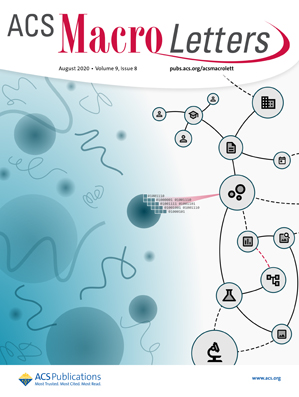低温电镜和原子力显微镜观察到的环状大分子链揭示了聚磷腈经典合成途径中的扩环聚合机制。
IF 5.2
Q1 POLYMER SCIENCE
引用次数: 0
摘要
当研究高摩尔质量聚有机磷腈在玻璃化水溶液中的低温电子显微镜(Cryo-EM)图像时,我们观察到具有不同环状拓扑结构的单个大分子链。单环链的存在是通过原子力显微镜(AFM)观察同一大分子在其吸收形式下的样品来证实的。高分子聚[二(羧基苯氧基)磷腈]PCPP是通过两个阶段合成的,包括开环聚合(ROP)和随后的大分子取代转化。大环的直径为20- 60nm,为高摩尔质量聚磷腈合成中常见的链生长过程中发生的环延伸聚合(REP)机制提供了直接证据。非对称流场流动分馏(AF4)分析表明存在一个更快的移动分数,这可能归因于大循环。本文章由计算机程序翻译,如有差异,请以英文原文为准。
Cyclic Macromolecular Chains Visualized by Cryo-EM and AFM Reveal a Ring Expansion Polymerization Mechanism in a Classical Synthetic Pathway to Polyphosphazenes.
We observed individual macromolecular chains with distinct ring topology when studying cryogenic electron microscopy (Cryo-EM) images of a high molar mass polyorganophosphazene in its vitrified aqueous solution. The presence of monocyclic chains was confirmed by visualizing samples of the same macromolecule in its absorbed form by using atomic force microscopy (AFM). The polymer, poly[di(carboxylatophenoxy)phosphazene], PCPP, is synthesized via a two-stage process, which includes a ring-opening polymerization (ROP) and a subsequent macromolecular substitution transformation. The visualization of macrocycles, which are 20-60 nm in diameter, provides direct proof of a ring extension polymerization (REP) mechanism occurring in the chain-growth process commonly employed for the synthesis of high molar mass polyphosphazenes. Asymmetric flow field flow fractionation (AF4) analysis shows the presence of a faster moving fraction, which can be potentially attributed to macrocycles.
求助全文
通过发布文献求助,成功后即可免费获取论文全文。
去求助
来源期刊
CiteScore
10.40
自引率
3.40%
发文量
209
审稿时长
1 months
期刊介绍:
ACS Macro Letters publishes research in all areas of contemporary soft matter science in which macromolecules play a key role, including nanotechnology, self-assembly, supramolecular chemistry, biomaterials, energy generation and storage, and renewable/sustainable materials. Submissions to ACS Macro Letters should justify clearly the rapid disclosure of the key elements of the study. The scope of the journal includes high-impact research of broad interest in all areas of polymer science and engineering, including cross-disciplinary research that interfaces with polymer science.
With the launch of ACS Macro Letters, all Communications that were formerly published in Macromolecules and Biomacromolecules will be published as Letters in ACS Macro Letters.

 求助内容:
求助内容: 应助结果提醒方式:
应助结果提醒方式:


